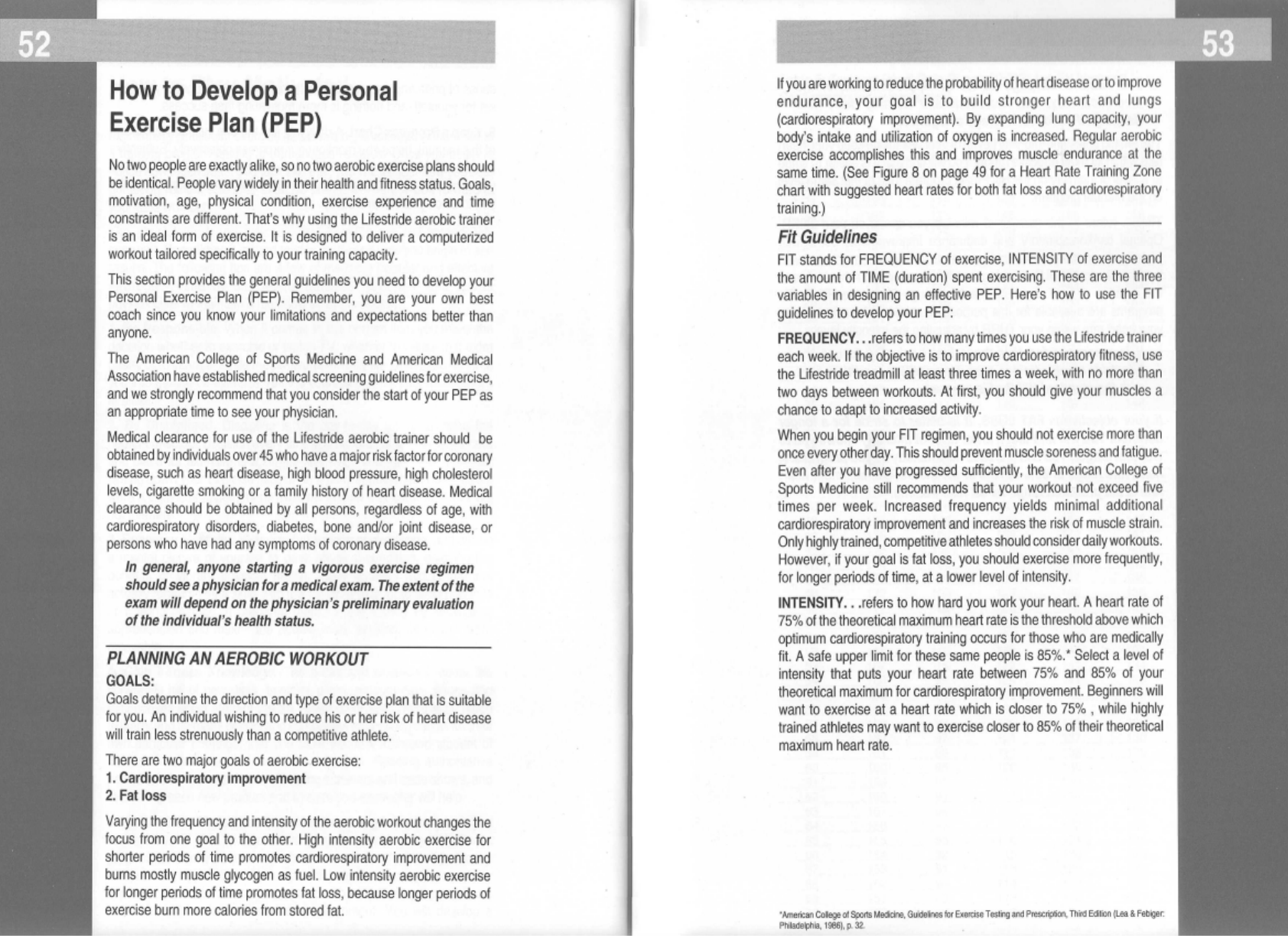
How to Develop a Personal
Exercise Plan (PEP)
If you are working to reduce the probability of heart disease or to improve
endurance, your goal is to build stronger heart and lungs
(cardiorespiratory improvement). By expanding lung capacity, your
body's intake and utilization of oxygen is increased. Regular aerobic
exercise accomplishes this and improves muscle endurance at the
same time. (See Figure 8 on page 49 for a Heart Rate Training Zone
chart with suggested heart rates for both fat loss and cardiorespiratory
training.)
Fit Guidelines
FIT
stands for FREQUENCY of exercise, INTENSITY of exercise and
the amount of TIME (duration) spent exercising. These are the three
variables in designing an effective PEP. Here's how to use the FIT
guidelines to develop your PEP:
FREQUENCY. . .refers to how many times you use the Lifestride trainer
each week. If the objective is to improve cardiorespiratory fitness, use
the Lifestride treadmill at least three times a week, with no more than
two days between workouts. At first, you should give your muscles a
chance to adapt to increased activity.
When you begin your FIT regimen, you should not exercise more than
once every other day. This should prevent muscle soreness and fatigue.
Even after you have progressed sufficiently, the American College of
Sports Medicine still recommends that your workout not exceed five
times per week. Increased frequency yields minimal additional
cardiorespiratory improvement and increases the risk of muscle strain.
Only highly trained, competitive athletes should consider daily workouts.
However, if your goal is fat loss, you should exercise more frequently,
for longer periods of time, at a lower level of intensity.
INTENSITY. . .refers to how hard you work your heart. A heart rate of
75% of the theoretical maximum heart rate is the threshold above which
optimum cardiorespiratory training occurs for those who are medically
fit. A safe upper limit for these same people is 85%. * Select a level of
intensity that puts your heart rate between 75% and 85% of your
theoretical maximum for cardiorespiratory improvement. Beginners will
want to exercise at a heart rate which is closer to 75% , while highly
trained athletes may want to exercise closer to 85% of their theoretical
maximum heart rate.
No two people are exactly alike, so no two aerobic exercise plans should
be identical. People vary widely in their health and fitness status. Goals,
motivation, age, physical condition, exercise experience and time
constraints are different. That's why using the Lifestride aerobic trainer
is an ideal form of exercise. It is designed to deliver a computerized
workout tailored specifically to your training capacity.
This section provides the general guidelines you need to develop your
Personal Exercise Plan (PEP). Remember, you are your own best
coach since you know your limitations and expectations better than
anyone.
The American College of Sports Medicine and American Medical
Association have established medical screening guidelines for exercise,
and we strongly recommend that you consider the start of your PEP as
an appropriate time to see your physician.
Medical clearance for use of the Lifestride aerobic trainer should be
obtained by individuals over 45 who have a major risk factor for coronary
disease, such as heart disease, high blood pressure, high cholesterol
levels, cigarette smoking or a family history of heart disease. Medical
clearance should be obtained by all persons, regardless of age, with
cardiorespiratory disorders, diabetes, bone and/or joint disease, or
persons who have had any symptoms of coronary disease.
In general, anyone starting a vigorous exercise regimen
should see a physician for a medical exam. The extent of the
exam will depend on the physician's preliminary evaluation
of the individual's health status.
PLANNING
AN AEROBIC
WORKOUT
GOALS:
Goals
determine the
direction
and type
of
exercise plan that
is
suitable
for you. An individual wishing to reduce his or her risk of heart disease
will train less strenuously than a competitive athlete.
There are two major goals
of
aerobic exercise:
1. Cardiorespiratory improvement
2. Fat loss
Varying the frequency and intensity of the aerobic workout changes the
focus from one goal to the other. High intensity aerobic exercise for
shorter periods of time promotes cardiorespiratory improvement and
burns mostly muscle glycogen
as
fuel. Low intensity aerobic exercise
for longer periods of time promotes fat loss, because longer periods
of
exercise burn more calories from stored fat.
'American College of Sports
Medicine. Guidelines
for
Exercise Testing and Prescription. Third Edition (Lea & Febiger:
Philadelphia.
1986), p.
32.


















